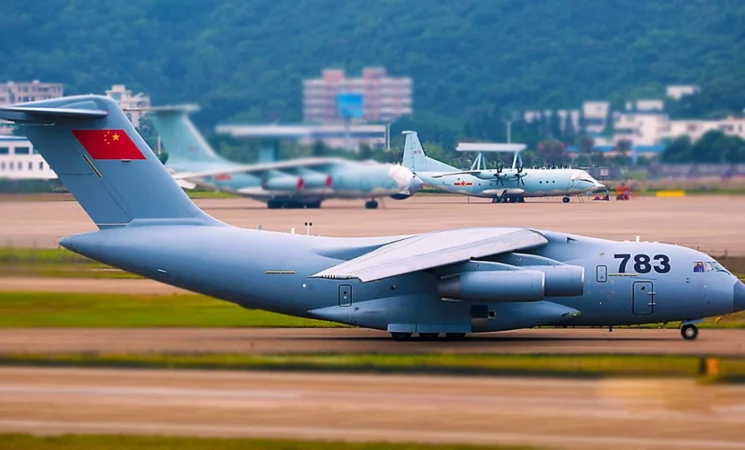14 September 2025, NIICE Commentary 11721
Ryan B Fernandes & Soumyadip Mondal
Recent developments surrounding the Lalmonirhat airbase in northern Bangladesh have re-emerged as a subject of strategic concern for India. Built by the British in 1931 and largely dormant since 1958, Lalmonirhat is now undergoing refurbishment, with reports of Chinese involvement. Officially, Dhaka has framed the project as part of a wider initiative to revive several disused airfields for civilian purposes and regional connectivity. Yet its location—barely 12 to 20 kilometres from the Indian border and around 135 kilometres from the Siliguri Corridor—has raised speculations across the border.
The Siliguri Corridor, also called the “Chicken’s Neck,” is a 200-kilometre stretch of land that connects the country’s northeastern states to the rest of the mainland. At its narrowest point, this corridor is only about 20 kilometres wide, sharing borders with Bangladesh, Nepal, and Bhutan. As such, it remains a critical part as the only land route connecting northeast India to the mainland, and any disturbances could have serious repercussions. Any infrastructure developments close to this corridor thus raise eyebrows, particularly when they carry even a remote prospect of dual-use military functionality.
Neighbourhood
Bangladesh has offered repeated assurances to New Delhi, including a statement in Parliament, that Lalmonirhat will be used exclusively for civilian purposes. However, India has maintained caution as China’s pattern of “infrastructure diplomacy”, ie dual-use infrastructure between civilian and military domains across the Indo-Pacific. The Belt and Road Initiative has produced ports, airports, and industrial hubs which, though presented as commercial projects, have demonstrated latent strategic potential. Examples range from Hambantota in Sri Lanka to Gwadar in Pakistan, and airstrips in Tibet and Xinjiang.
For India, the risks are present due to the geographical nature and importance of the chicken’s neck. A military establishment near the border could be used for intel gathering nd reconnaissance. Even if no military aircraft are stationed there, the very existence of the facility adds an element of strategic ambiguity. It could also allow China to exert pressure if there is any repeat of the border standoffs of the past.
Indian Response
India has not remained passive. Reports suggest that New Delhi has already deployed the S-400 Triumf air defence system within range of the Siliguri Corridor, enhancing both surveillance and interception capability. The Indian military has also intensified military exercises in North Bengal and Assam, post-operation Sindoor, as a show of strength. Reports about refurbishing a 1971 wartime airport in Tripura have also surfaced. Beyond the military realm, diplomacy has been mobilised as well: India has sought clarifications from Dhaka and worked to strengthen political and economic ties with both Bangladesh and Bhutan. The aim remains to move cautiously, ie to ensure Lalmonirhat remains for civilian use while also reinforcing goodwill and trust with its neighbours.
The changing balance of power in South Asia is the bigger picture. Through technical assistance, arms sales, and infrastructure funding, Bangladesh has increased its economic ties with China. Chinese participation gives Dhaka access to capital and knowledge on a scale that India finds difficult to match. The investment presents Beijing with a chance to increase its strategic presence in India's immediate neighbourhood. This interaction draws attention to New Delhi's main problem, matching China’s growing influence in the neighbourhood.
In this regard, India’s long-term response must be multifaceted. Strengthening its own connectivity projects in the Northeast is one critical step. By diversifying routes—through expanded road and rail links, inland waterways, and cross-border corridors with Bhutan, Nepal, and Bangladesh—India can reduce its overdependence on the Siliguri Corridor. In parallel, India must continue to offer Bangladesh credible alternatives in infrastructure and investment, ensuring that Dhaka does not feel compelled to rely disproportionately on Chinese financing. Strategic partnerships should also extend to joint training, technology sharing, and confidence-building measures that reassure both sides of benign intent.
Conclusion
However, the long-term idea of the militarisation of the airport should be taken into consideration. Bangladesh would most likely not be willing to risk its relationships with India and the subsequent diplomatic backlash. Nevertheless, the ambiguity inherent in dual-use facilities means that India cannot simply dismiss the project as harmless. The Lalmonirhat episode reflects broader shifts in the Indo-Pacific security environment, where infrastructure has emerged as a form of strategic currency capable of reshaping power dynamics, signalling intent, and influencing alignments.
For India, the task is not merely to reinforce defences around the Siliguri Corridor but to craft a comprehensive regional strategy that integrates economic cooperation, diplomatic engagement, and military preparedness.. Ultimately, Lalmonirhat is best understood as part of a wider trend of infrastructure development across South Asia, where multiple actors, including China, are contributing to the transformation of regional connectivity. Such initiatives underscore both the promise of economic growth and cross-border integration and the potential for strategic complications. India’s regional credibility will depend on its ability to safeguard vital areas like the Siliguri Corridor while also positioning itself as a partner of choice by offering viable developmental alternatives. Striking the right balance between constructive engagement and security readiness will be critical to ensuring that infrastructure serves as a source of stability rather than conflict.
Ryan B Fernandes & Soumyadip Mondal are currently pursuing a Master’s degree in International Relations at Christ (Deemed To Be University), Bangalore, India.
The views expressed here are the author's own.

